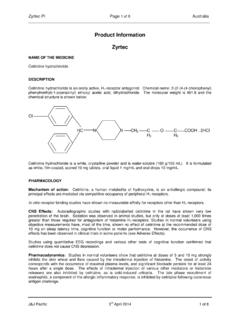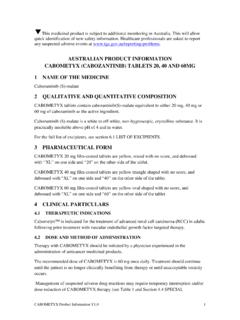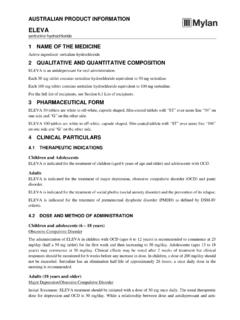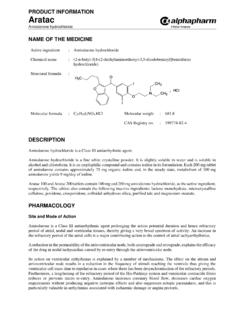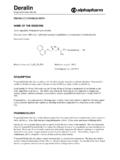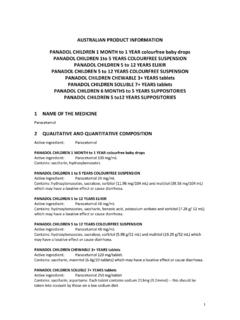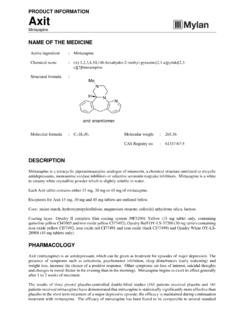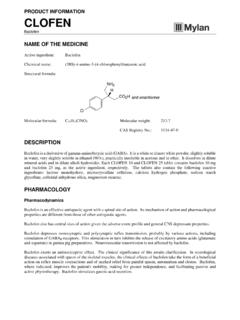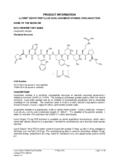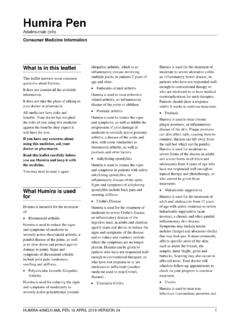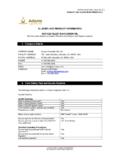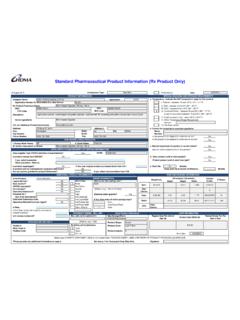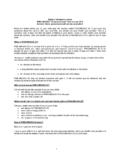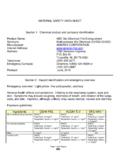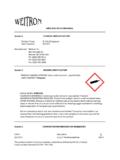Transcription of AUSTRALIAN PRODUCT INFORMATION NORGESIC ... - Medicines.org.au
1 1 AUSTRALIAN PRODUCT INFORMATION NORGESIC (ORPHENADRINE AND PARACETAMOL) TABLETS 1 name OF THE MEDICINE Orphenadrine and paracetamol 2 QUALITATIVE AND QUANTITATIVE COMPOSITION Orphenadrine citrate 35 mg and paracetamol 450mg tablets. For the full list of excipients, see Section List of excipients. 3 PHARMACEUTICAL FORM Tablet, uncoated White, scored, immediate release tablets marked N/C on one side and no markings on the other side. 4 CLINICAL PARTICULARS THERAPEUTIC INDICATIONS Tension headache, occipital headaches associated with spasm of skeletal muscles in the region of the head and neck. Acute and traumatic conditions of the limbs and trunk: sprains, strains, whiplash injuries, acute torticollis, prolapsed intervertebral disc.
2 DOSE AND METHOD OF ADMINISTRATION 2 tablets three times daily. CONTRAINDICATIONS Glaucoma Prostatic hypertrophy or obstruction at the bladder neck, Myasthenia gravis Oesophageal spasm and pyloric or duodenal obstruction. Hypersensitivity to paracetamol or orphenadrine citrate. SPECIAL WARNINGS AND PRECAUTIONS FOR USE Identified precautions Orphenadrine citrate should be used with caution in patients with tachycardia, cardiac decompensation, coronary insufficiency or cardiac arrhythmias. Paracetamol should be used with caution in patients with hepatic or renal dysfunction. 2 Concomitant treatment with other medicines that contain orphenadrine or paracetamol is not recommended.
3 Safety of continuous long-term therapy with orphenadrine has not been established. Therefore if orphenadrine is prescribed for prolonged use, periodic monitoring of blood, urine and liver function is recommended. Use in the elderly The elderly should be advised to take a reduced dosage as they may be more susceptible to anti-cholinergic side effects at regular doses. Paediatric use NORGESIC is not recommended for children under 12 years of age. Effects on laboratory tests INTERACTIONS WITH OTHER MEDICINES AND OTHER FORMS OF INTERACTIONS Interactions have been reported between orphenadrine and phenothiazines and other drugs with anti-muscarinic properties. Concomitant use with alcohol or other CNS depressants should be avoided.
4 Anticoagulant dosage may require reduction if paracetamol medication is prolonged. Paracetamol absorption is increased by medicines that increase gastric emptying, metoclopramide, and decreased by medicines that decrease gastric emptying, propantheline, antidepressants with anticholinergic properties and narcotic analgesics. Paracetamol may increase chloramphenicol concentrations. The likelihood of paracetamol toxicity may be increased by the concomitant use of enzyme inducing agents such as alcohol or anticonvulsant medicines. FERTILITY, PREGNANCY AND LACTATION Effects on fertility No data available Use in pregnancy Pregnancy Category B2 NORGESIC is not recommended for use during pregnancy.
5 Use in lactation. NORGESIC should not be taken during lactation as orphenadrine and paracetamol are excreted into breast milk. EFFECTS ON ABILITY TO DRIVE AND USE MACHINES Orphenadrine may impair the ability of the patient to engage in potentially hazardous activities such as operating machinery or driving a motor vehicle; ambulatory patients should therefore be cautioned accordingly. 3 ADVERSE EFFECTS (UNDESIRABLE EFFECTS) Adverse effects are mainly due to the anti-cholinergic action of orphenadrine and are usually associated with higher doses. Orphenadrine citrate More common reactions The known adverse effects include; dryness of the mouth, tachycardia, palpitation, urinary hesitancy or retention, blurred vision, dilation of the pupils, increased ocular tension, weakness, nausea, headache, dizziness, constipation and drowsiness.
6 These effects can usually be eliminated by reducing the dose . Less common reactions Sedation, skin rashes and other allergic reactions are very uncommon adverse effects. Infrequently an elderly patient may experience some degree of mental confusion. Very rare cases of aplastic anaemia associated with the use of orphenadrine have been reported. Paracetamol Reports of adverse reactions are rare. Although the following reactions have been reported, a causal relationship to the administration of paracetamol has been neither confirmed nor refuted; dyspepsia, nausea, allergic and haematological reactions. Reporting suspected adverse effects Reporting suspected adverse reactions after registration of the medicinal PRODUCT is important.
7 It allows continued monitoring of the benefit-risk balance of the medicinal PRODUCT . Healthcare professionals are asked to report any suspected adverse reactions at OVERDOSE For INFORMATION on the management of overdose, contact the Poisons INFORMATION Centre on 13 11 26 (Australia). No specific INFORMATION is available on overdosage with NORGESIC . Overdose of paracetamol can result in severe liver damage and sometimes acute renal tubular necrosis. Symptoms and Signs Orphenadrine overdosage: Known symptoms of overdose with orphenadrine include tachycardia, excitement, confusion and delirium leading to coma. Convulsions, dilated pupils and urinary retention may occur.
8 Paracetamol overdosage: Toxic symptoms following an overdose with paracetamol include vomiting, abdominal pain, hypotension, sweating, central stimulation with exhilaration and convulsions in children, drowsiness, respiratory depression, cyanosis and coma. In adults, hepatotoxicity may occur after ingestion of a single dose of paracetamol 10 to 15g; a dose of 25g or more is potentially fatal. 4 Symptoms during the first two days of acute poisoning by paracetamol do not reflect the potential seriousness of the intoxication. Major manifestations of liver failure such as jaundice, hypoglycaemia and metabolic acidosis may take at least three days to develop. Treatment Prompt treatment is essential even when there are no obvious symptoms.
9 In cases of overdosage, methods of reducing absorption of ingested medicine are important. Prompt administration of activated charcoal 50 g in 150 mL of water and 150 mL sorbitol 50% solution by mouth may reduce absorption. It is recommended that intravenous fluids such as normal saline be given concurrently. Gastric lavage is indicated if the patient is unwilling or unable to drink an activated charcoal/sorbitol mixture. If the history suggests that paracetamol 150mg/kg body weight or 15 g total or more has been ingested, administer the following antidote: Intravenous acetylcysteine 20%: Administer acetylcysteine immediately without waiting for positive urine test or plasma level results if 8 hours or less since overdose ingestion.
10 Initial dose 150 mg/kg over 15 minutes, followed by continuous infusion of 50 mg/kg in glucose 5% 500 mL over four hours and 100 mg/kg in glucose 5% 1 L over 16 hours. If more than eight hours have elapsed since the overdose was taken, the antidote may be less effective. Convulsions and delirium respond to relatively large doses of diazepam, preferably by mouth. Adequate hydration of the patient is important. 5 PHARMACOLOGICAL PROPERTIES PHARMACODYNAMIC PROPERTIES Mechanism of action Orphenadrine is a skeletal muscle relaxant. Paracetamol is an analgesic and antipyretic. PHARMACOKINETIC PROPERTIES No data available PRECLINICAL SAFETY DATA Genotoxicity No data available.
